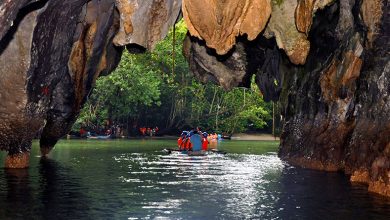The Pre-Colonial Period
Prehistoric man is believed to have first settled in the Philippines 250,000 years ago, but on the basis of the most recent discoveries in the Palawan caves, the oldest human fossils remains are about to between 40,000 and 50,000 years ago. These remains suggest that the first human migrations to the islands took place during the last Ice Age, where the water barrier was much less. On a Paleolithic level of culture, the Negritos or Aetas are the first inhabitants. They are Australo-Melanesian people which stand between 1.10 and 1.20 m high with dark skin, crisp curly hair, thick lips and flat nose. They lived by food-gathering and hunting. They use bows and arrows, blowpipes and practice slash-and burn farming but appear to have no religious beliefs. Their descendants are still to be found in the Philippines, living in remote mountain areas in the Zambales; Ilocos; some part of Northern Luzon; Bicol; in most southerly islands; and in the Visayas (Negros and Panay). The theory that they arrived in the Philippines overland, when the archipelago was still connected with the mainland, is now discredited.
These first inhabitants were followed by successive waves of Proto-Malaysians, known as Indonesians. The first set of Indonesians arrived around 5000 B.C. while the second one arrived about 3500 B.C. The former were tall, slender and light-skinned, with angular features pointing to a Mongol origin; the latter were small and dark-skinned, with less marked features. The first group, who were of Paleolithic culture, was driven into the interior by the second group, who was of more advanced Neolithic culture and practised non-irrigated farming. The descendants of the second group of Indonesians are now known as Kalingas, Ifugaos, Bontocs, Gaddangs and Apoyaos on Luzon, Tagbanuas on Palawan and Bagobos, and Bilaans, Manobos and Tirurays on Mindanao. They live in remote regions into which they were driven by the numerically superior Malaysians who arrived during the 1st millennium B.C. and had the advantage of practising stock rearing and a more advanced agriculture and the use of metals.
There were further movements of Malaysians into the Philippines over a long period ranging from the beginning of the Christian era to the 13th century. While the earlier settlers probably came from the interior of Asia, these later arrivals are thought to have come from the coasts of the South-East Asian peninsula and particularly from Malaya.
None of the successive neighbouring empires seems to have exercised political supremacy over the Philippines. Relations with China were mainly commercial, and trade developed on a considerable scale under the Sung dynasty (960-1127); it probably began at an earlier stage, though there are no documents to prove it. There was a steady movement of Chinese into the Philippines for the purposes of trade.
The Malaysians also served as intermediaries between India and the Philippines, and were responsible for the few Indian religious and linguistic features still to be observed in the Philippines. The spread of Indian ideas was promoted by the two great Malaysian empires which extended their influence all over South-East Asia, Srivijaya (around 650 A.D.) and Modjapahit, which reached its peak about 1400 A.D.
Islamic influences reached the Philippines in the same way, as a result of exchanges within the Malaysian world, but there were also direct contacts through the intermediary of Arab traders. It is perhaps doubtful to what extent these merchants themselves disseminated Islam, but they were followed by a number of missionaries. By the last quarter of the 13th century, or perhaps a little earlier, Sulu had a foreign Muslim community; and the numbers of Muslims increased in the 15th century with the arrival of Malaysians from Sumatra, and particularly of Rajah Baguinda. The first Muslim missionary on Mindanao is believed to have arrived about the middle of the 15th century; and when the Spaniards came to the Philippines in 1521 there were Muslims on Luzon, particularly at Manila.




